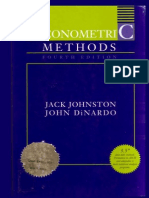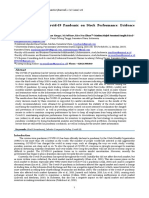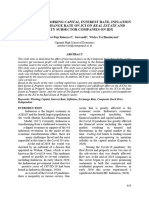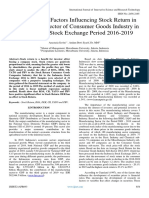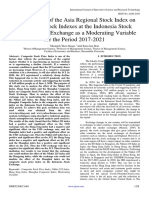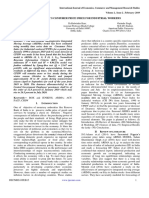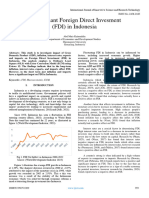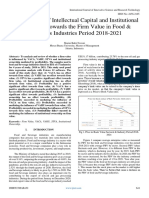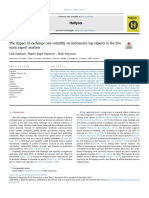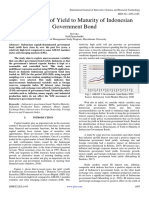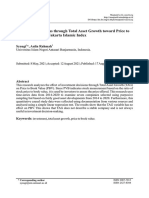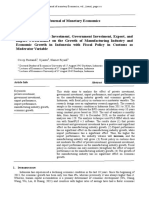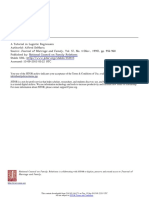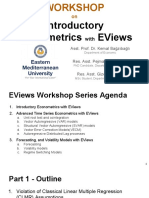Professional Documents
Culture Documents
Relationship Between Macroeconomic Variables and Stock Market Composite Index Evidence From Indonesia
Copyright
Available Formats
Share this document
Did you find this document useful?
Is this content inappropriate?
Report this DocumentCopyright:
Available Formats
Relationship Between Macroeconomic Variables and Stock Market Composite Index Evidence From Indonesia
Copyright:
Available Formats
Volume 6, Issue 6, June – 2021 International Journal of Innovative Science and Research Technology
ISSN No:-2456-2165
Relationship between Macroeconomic Variables and
Stock Market Composite Index: Evidence from
Indonesia
Naimah Andam Dewi
Mercu Buana University, Jakarta, Indonesia Mercu Buana University, Jakarta, Indonesia
Abstract:- This study aims to determine and analyze the Microeconomic factors are economic factors related to
effect of inflation, exchange rates, gross domestic product the company's internal conditions, while macroeconomic
(GDP), and interest rates on the composite stock price factors are factors that exist outside the company (Afiyati &
index on the Indonesia Stock Exchange for the 2015-2019 Topowijono, 2018). Microeconomic variables generally discuss
period. This study uses a quantitative approach. The aspects that can be analyzed through financial ratios, including
samples used are inflation data from the Central Statistics liquidity ratios, activity, probability, solvency, and market
Agency, the USD/IDR exchange rate (JISDOR) from Bank value (David Wijaya, 2017). While macroeconomic variables
Indonesia, GDP data based on current prices from the generally discuss interest rates, economic cycles, inflation,
Central Statistics Agency, and interest rates published by government policies related to specific companies, exchange
Bank Indonesia with an observation period of 5 years rates, tax regulations, budget deficits, interest rates on foreign
quarterly. The data used in this research is secondary data. loans, international economic conditions, understanding of the
This research technique uses Multiple Linear Regression economy, money supply, private investment. Balance of trade
analysis on time series data using the eviews 10 and payments, and GDP (Samsul, 2006; Tandelilin, 2010). This
application. The results indicate that inflation, exchange paper discusses macroeconomic factors in inflation, exchange
rates, and interest rates do not affect the Jakarta rates, GDP, and interest rates because the announcement of
Composite Index (JCI), while GDP has a positive and information about these variables always attracts investors'
significant effect on the JCI. attention, both daily and periodically.
Keywords:- Inflation, Exchange Rate, GDP, Interest Rates. Mostly, high inflation is a negative signal for companies
because the price of raw materials has increased. With the
I. INTRODUCTION increase in production costs, the increase in product prices
cannot be avoided. As a result, the level of sales within the
The industrial world is now facing a new phase called the company will decrease, followed by a decrease in company
Industrial Revolution 4.0, marked by rapid changes in the profits and, of course, will be responded negatively by
current digital era (Athiyah, 2008). However, the issue of investors in the capital market (Sukirno, 2015). Figure II shows
capital is still an obstacle for business actors to develop. They that inflation tends to decrease with quite significant
cannot meet the number of orders or consumer demand due to a fluctuations. Therefore, theoretically, an increase in inflation
lack of costs for production. Therefore, it is undeniable that the should cause the JCI to decline. However, from Q1-2016 to
role of the capital market is increasingly needed over time. In Q2-2016, when inflation is likely to rise, stock index
this case, the capital market plays a significant role in offering movements tend to follow the direction of the movement of
solutions to capital problems that business actors often face. In inflation.
its journey, the Indonesian capital market has experienced
various fluctuations in response to economic factors, both Fig. II JCI and Inflation Movement 2015- 2019
macro and micro, as shown in Figure 1.
Fig. I IDX Composite Index Movement January 2013-
December 2019
The exchange rate is also a variable that can affect stock
prices. Sukirno (2015) said the low price of imported goods
would increase the number of imports. Conversely, high prices
for imported goods will reduce imports. Companies in sectors
that often import their material will feel the impact of the
IJISRT21JUN803 www.ijisrt.com 1626
Volume 6, Issue 6, June – 2021 International Journal of Innovative Science and Research Technology
ISSN No:-2456-2165
exchange rate fluctuation. The burden of production costs due Fig. V JCI and Interest Rate Movement 2015-2019
to the weakening of the rupiah will cause the stock price to
stumble. Therefore, theoretically, exchange rate depreciation
should cause the JCI to decline. However, Figure III shows that
the movement of JCI tends to follow the exchange rate
movement between 2016 to 2017.
Fig. III JCI and Exchange Rate Movement 2015- 2019
Results of research conducted by Sabilla and Kurniasih
(2020), Adesanmi and Jatmiko (2017), Rusbariand et al.
(2012), and Siregar et al. (2014) find inflation has a negative
effect on the stock price index. In contrast, Mulyani's (2012)
research found that inflation positively affects the stock price
index. But Rachmawati et al. (2015) and Kusuma and Badjra
(2016) find that inflation does not affect the stock price index
GDP includes factors that affect changes in stock prices.
Theoretically, it can be explained that an increase in GDP can Amadasu (2012), Lukisto and Anastasia (2014), Kusuma
indicate an increase in consumer purchasing power towards and Badjra (2016) state that the exchange rate positively affects
production so that the company's profitability is estimated to stock prices. However, other studies have found different
increase. The increase in the company's profitability will be findings. For example, Harsono and Worokinasih (2018) and
responded to positively by investors to increase the share price Suriani et al. (2015) found that the exchange rate had no effect
(Tandelilin, 2007). However, in Figure IV, it can be seen that on the stock market, and the findings of Kabeer (2017) and
GDP tends to rise steadily in the 2015-2019 period. Husnul et al. (2017) showed that the exchange rate negatively
Theoretically, a stable increase in GDP should be followed by impacts stock prices.
the stable movement of the JCI. However, between 2015 and
2018, the JCI tends to fluctuate and is not in line with GDP. Asih and Akbar (2017) and Hooker (2004) found that
GDP has a positive and significant effect on stock returns.
Fig. IV JCI and GDP Movement 2015-2019 However, Asmara and Asmara (2018) found different things,
where GDP growth did not significantly affect the stock
market.
The study conducted by Muhammad et al. (2016),
Hussain et al. (2013), and Triani (2013) shows that the interest
rate negatively correlates with stock prices. Meanwhile,
Ningsih and Waspada (2018) and Apergis and Eleftheriou
(2002) state that their research results show that the interest rate
does not affect the stock market.
Considering the background of the problems disclosed by
In general, interest rates exercise a pervasive influence the researchers and the differences from the results of previous
over economic decisions and performance. They influence the studies, this paper discusses the issues surrounding the effect of
willingness to save and influence the demand for and allocate inflation, exchange rates, GDP, and interest rates on the JCI
borrowed funds (Lanyi and Saracoglu, 1983). High-interest during the period 2015 to 2019. The period from 2015 to 2019
rates will make investors switch to savings or time deposits, was chosen with the author's consideration. The 5-year time
resulting in stocks not being demanded so that stocks will fall. span is sufficient to represent market conditions and avoid
However, Figure V has shown that the JCI tends to follow the abnormal situations due to the pandemic that hit the capital
movement of interest rates. Between Q1-2018 to Q2-2019, the market in 2020.
JCI should have moved in the opposite direction against
interest rates.
IJISRT21JUN803 www.ijisrt.com 1627
Volume 6, Issue 6, June – 2021 International Journal of Innovative Science and Research Technology
ISSN No:-2456-2165
II. THEORY STUDY rate relative to the currencies of other countries will encourage
an increase in exports and reduce the pace of import growth.
A. Signaling Theory
Signaling theory is one of the pillar theories in F. Gross Domestic Product (GDP)
understanding financial management. In general, the signal is One of the essential indicators to determine the economic
interpreted as a signal made by the company (manager) to conditions in a country in a certain period is GDP data, both at
outside parties (investors). These signals can take the form of current prices and at constant prices. GDP is the amount of
various forms. Both can be directly observed and need to be added value produced by all business units in a particular
examined in more depth to find out (Gumanti, 2009). country or is the total value of final goods and services
produced by all economic units.
B. Capital Asset Pricing Model
In 1960, William F. Sharpe, Litner, and Mossin G. Interest Rate
developed the Capital Asset Pricing Model (CAPM) for the The interest rate is one of several monetary economic
first time. The CAPM is a model that provides a measure of the indicators. The policy interest rate may be required to keep
risk of particular securities that are consistent with portfolio aggregate supply and demand in balance and inflation on target
theory. This model calculates the undiversified risk of a single over the medium term. Thus, supporting the growth of the
portfolio and compares it with the well-diversified risk. This economy.
CAPM model explains that the profit level of an asset or stock
is equivalent to the risk-free rate of return plus a risk premium. III. HYPOTHESIS AND THINKING FRAMEWORK
C. Arbitrage Pricing Theory Based on the explanations, the hypothesis of this research
Arbitrage Pricing Theory (APT) is a theory from Stephen is:
A. Ross developed from the CAPM theory where APT states 1. inflation has a significant effect on the JCI for the 2015-
that the estimated expected return can be influenced by various 2019 period
factors (multifactor) while the CAPM price is only influenced 2. the exchange rate has a significant effect on the JCI for the
by one factor, namely the market portfolio. The APT 2015-2019 period
multifactor model identifies the number of factors and looks for 3. GDP has a significant effect on the JCI for the 2015-2019
the relationship of these factors to security returns, then period
determines these factors with macro indicators. The assumption 4. interest rates have a significant effect on JCI for the 2015-
that underlies APT is "the law of one price," which is different 2019 period
from the assumption of the CAPM concept. APT describes two
or more securities with the same risk, and this means that each The framework can be described as follows:
security cannot be sold at a different price if the same factors
influence the security in the same economy. The multifactor Fig. VI Thinking Framework
model can be written with the following equation:
rit = ai + bi1F1t + bi2F2t + … + bikFkt + eit
D. Inflation
The inflation rate is the rate of change in the general price
level and is measured as follows (Samuelson and Nordhaus,
2004):
Price 𝑡ℎ𝑡 − Price 𝑡ℎ𝑡−1
Inflation 𝑡ℎ𝑡 = 𝑥 100%
𝑃𝑟𝑖𝑐𝑒 (th t)
Conceptually, the price level is measured as the weighted
average of the goods - goods and services - services IV. RESEARCH METHODS
economy. However, the overall price level is measured by
creating a price index which is the average consumer or A. Research Design
producer price. This study aims to determine and analyze the effect of
inflation, exchange rates, GDP, and interest rates on the
E. Exchange rate composite stock price index on the Indonesia Stock Exchange
The rupiah exchange rate compares the value or price of for the 2015-2019 period.
the rupiah currency with other currencies. Trade between
countries in which each country has its medium of exchange B. Data / Information Sources
requires comparing the value of one currency with another, The data obtained in this study is secondary
which is called the foreign exchange rate or exchange rate data. Secondary data is a source of research data obtained by
(Salvatore, 2008). The exchange rate policy is implemented to researchers indirectly through intermediary media (obtained
control the balance of payment transactions. A low exchange and recorded by other parties). The data collected is based on
IJISRT21JUN803 www.ijisrt.com 1628
Volume 6, Issue 6, June – 2021 International Journal of Innovative Science and Research Technology
ISSN No:-2456-2165
JCI movements, inflation, exchange rate data, GDP data, and 2. Autocorrelation Test
interest rates quarterly.
Table III Result of autocorrelation test
C. Population and Samples Breusch-Godfrey Serial Correlation LM Test:
This study uses population data in the form of the JCI F-statistic 1.662689 Prob. F(2,13) 0.2275
price index. According to the criteria set, the research objects Obs*R-squared 4.073875 Prob. Chi-Square(2) 0.1304
are the JCI price index data every quarter for five years from
2015 – 2019.
From the results of the autocorrelation test, the
D. Data Analysis Method probability value of 0.1304> 0.05, it can be concluded that
The analytical method used to analyze the data in this there is no autocorrelation symptom in the research model.
study is to use quantitative analysis. Quantitative analysis uses
formula numbers or mathematical models to determine whether 3. Multicollinearity Test
or not there is an effect of inflation, rupiah exchange rate, GDP,
and interest rates on the JCI. The data analysis technique used Table IV Result of Multikolinearitas
Inflation Exchange Rate GDP Interest Rate
in this research is using linear regression analysis. The analysis
Inflation 1,000000000 -0,230998677 -0,696896832 0,623521172
stages of this research are descriptive statistical analysis, Exchange Rate -0,230998677 1,000000000 0,613542220 0,143602630
classical assumption test, multiple linear regression analysis, GDP -0,696896832 0,613542220 1,000000000 -0,487109884
and hypothesis testing Interest Rate 0,623521172 0,143602630 -0,487109884 1,000000000
Multiple linear regression analysis model can be
From the results of the multicollinearity test above, it can
formulated as follows: be seen that the correlation value of all variables is less than
𝑌 = 𝛼 + 𝑏1 𝐼𝑛𝑓𝑙𝑎𝑠𝑖 + 𝑏2 𝑁𝑖𝑙𝑎𝑖 𝑇𝑢𝑘𝑎𝑟 + 𝑏3 𝑃𝐷𝐵 + 𝑏4 𝑆𝑢𝑘𝑢 𝐵𝑢𝑛𝑔𝑎 + 𝜀
0.7, so it can be concluded that there is no multicollinearity
problem in the research variables.
V. RESEARCH RESULTS AND DISCUSSION
4. Heteroskedasticity Test
A. Descriptive Statistics
Table V Result of Heteroskedasticity
Table I Result in Descriptive Statistics Heteroskedasticity Test: White
JCI Inflation Exchange Rate GDP Interest Rate
Mean 5643,970 3,836500 13778,60 3409459 5,662500 F-statistic 1.280882 Prob. F(14,5) 0.4201
Obs*R-squared 15.63935 Prob. Chi-Square(14) 0.3359
Median 5814,472 3,375000 13652,00 3428758 5,250000 Scaled explained SS 7.259822 Prob. Chi-Square(14) 0.9242
Maximum 6468,755 7,260000 14929,00 4067227 7,500000
Minimum 4223,908 2,530000 12998,00 2728181 4,250000
Std. Dev. 654,8797 1,385133 570,1859 417543,1 1,144998 The test result of heteroskedasticity using the White
Observations 20 20 20 20 20 method obtained the value of probability Obs * R- squared
value of 0, 3359 > 0.05 so that no symptoms of
heteroskedasticity in mod e l research can be concluded.
B. Inferential Statistics
C. Linear Regression Analysis
1. Data Normality Test The following is a table of multiple linear test results.
Dependent Variable: JCI
Method: Least Squares
Table II Result of Data Normality Test Sample: 2015Q1 2019Q4
Table VI Result of multiple linear tests
Included observations: 20
Variable Coefficient Std. Error t-Statistic Prob.
Inflation 61.97103 87.94679 0.704642 0.4918
Exchange_Rate -0.448745 0.225450 -1.990447 0.0651
GDP 0.001760 0.000388 4.530821 0.0004
Interest_Rate -41.10546 106.8175 -0.384819 0.7058
C 5822.662 2114.672 2.753459 0.0148
R-squared 0.789383 Mean dependent var 5643.970
Adjusted R-squared 0.733219 S.D. dependent var 654.8797
S.E. of regression 338.2512 Akaike info criterion 14.69777
Sum squared resid 1716208. Schwarz criterion 14.94671
Log likelihood -141.9777 Hannan-Quinn criter. 14.74637
F-statistic 14.05484 Durbin-Watson stat 1.029289
Prob(F-statistic) 0.000058
From normality test results, it can be seen that the value
of Jarque Berra probability of 0.459262> 0.05, meaning that Based on the results of multiple linear tests, it can be
residuals are normally distributed research data. formulated that the regression model of this study is :
JCI = 5822.66185147 + 61.9710347519*INFLATION -
0.448745238736*EXCHANGE_RATE +
0.00175963324862*GDP - 41.1054595587*INTEREST RATE
IJISRT21JUN803 www.ijisrt.com 1629
Volume 6, Issue 6, June – 2021 International Journal of Innovative Science and Research Technology
ISSN No:-2456-2165
1. Result of F test In contrast to the inflation and exchange rate variables,
From Table VI, the probability value of F-statistic is research on the GDP variable shows that GDP significantly
0.000058, and when compared with the specified degree, it is affects the JCI for 2015 to 2019. The results are supported by
5%, so that the significance value of F is smaller than the previous research conducted by Asih and Akbar (2017) and
degree of error (<0.05). Because this value is smaller than the Hooker (2004). In both studies, they stated that GDP had a
degree of error, it can be concluded that the independent significant positive effect on the stock market. In the study
variables jointly affect the dependent variable. period, GDP increased significantly from year to year, and this
can be seen followed by the movement of the JCI. An increase
2. Coefficient Determination in GDP indicates economic growth. If a country's economic
In Table VI, the Adjusted R-squared value is 0.733219, growth improves, the people's purchasing power will also
indicating that 73.3219% of the JCI variable can be explained increase, which is an opportunity for companies to increase
quite well by the four variables, namely inflation, exchange their sales. By increasing the company's sales, the company's
rates, GDP, and interest rates together. At the same time, the profits will also increase to positively impact the company's
remaining 26.6781% is explained by other variables not stock price and subsequently affect the JCI on the Indonesia
examined in this study. Stock Exchange (IDX). Besides that, good economic growth
also reflects the state of the country's economy, which is stable
3. Result of t-test so that investors do not hesitate to invest their funds in the
Based on the test results in Table VI, it can be explained capital market.
the influence between variables as follows:
i. the inflation rate produces a probability value of 0.4918, Finally, the research results on the interest rate variable
and it can be concluded that the inflation variable does not show that interest rates have no significant effect on the JCI for
affect the JCI, 2015 to 2019. The results of this study are supported by
ii. the exchange rate produces a probability value of 0.0651, previous research conducted by Ningsih and Waspada (2018)
and it can be concluded that the exchange rate variable does and Apergis and Eleftheriou (2002), which stated that interest
not affect the JCI, rates did not affect the stock market. During the study period
iii. GDP level produces a probability value of 0.0004, so it can (January 2015 – December 2019), the interest rate was
be concluded that the GDP variable has a positive effect on the relatively stable, with a sloping tendency in connection with the
JCI, and government's policy of keeping interest rates low. With low
iv. The interest rate variable produces a probability value of and stable interest rates that tend to slope, the movement of the
0.7058, so it can be concluded that the interest rate variable JCI index for the period 2015 to 2019 is not much influenced
does not affect the JCI. by fluctuations in interest rates, so the interest rate variable in
this study has not been able to influence the stock market.
D. Discussion
The results show that inflation has no significant effect on VI. CONCLUSIONS & SUGGESTION
the JCI for the period 2015 to 2019. The results of this study
are supported by research conducted by Rachmawati et al. A. Conclusions
(2015) and Kusuma and Badjra (2016), which stated in their Based on the results of research and discussions that have
research that the inflation rate partially did not affect the stock been carried out, it can be concluded that:
market. The inflation rate that occurred during the study period 1. the inflation variable has no effect on the JCI for the 2015-
(January 2015 – December 2019) was relatively stable and with 2019 period;
an average of below 5% year to year. With low and stable 2. the exchange rate variable has no effect on the JCI for the
inflation that tends to slop, the movement of the JCI index for 2015-2019 period;
the period 2015 to 2019 is not much influenced by fluctuations 3. the variable GDP has a positive effect significantly on the
in inflation, so that the inflation variable in this study has not JCI for the 2015-2019 period; and
been able to influence the stock market. 4. the interest rate variable has no effect on the JCI for the
2015-2019 period.
In line with the inflation variable, the study results show
that the exchange rate has no significant effect on the JCI for B. Suggestion
2015 to 2019. The results of this study are supported by Based on the research and conclusions that have been
previous research by Harsono and Worokinasih (2018) and drawn, there are several practical suggestions that researchers
Suriani et al. (2015), who stated in their research that the can give, including:
exchange rate did not affect the stock market. Investors are 1. For academics, the results of this study can be used as a
suspected of coping with exchange rate fluctuations that reference related to financial management and are expected
occurred in 2015 and 2018. The exchange rate during the study to provide a deeper understanding of the influence of
period was relatively stable between Rp13,000-Rp14,900 and macroeconomic variables on stock price movements.
had not crossed the psychological limit of Rp15,000. Plus, 2. For investors, this research is expected to understand
other variables such as stable inflation and the dominant macroeconomic variables and their influence on stock
portion of domestic investor trading (>70%) in the capital prices, especially the GDP variable, so that they can make
market resulting in no significant fluctuations due to exchange optimal investment decisions in response to relevant
rate movements. circumstances.
IJISRT21JUN803 www.ijisrt.com 1630
Volume 6, Issue 6, June – 2021 International Journal of Innovative Science and Research Technology
ISSN No:-2456-2165
3. Capital market regulators are expected to use this research's [10]. Harsono, A. R., & Worokinasih, S. (2018). Pengaruh
results to formulate appropriate policies if relevant market Inflasi, Suku Bunga, dan Nilai Tukar Rupiah Terhadap
conditions indicate maintaining capital market stability. Indeks Harga Saham Gabungan (Studi pada Bursa Efek
4. For company management (issuers), to be able to Indonesia Periode 2013-2017). Jurnal Administrasi
immediately respond in an accountable and transparent Bisnis, 60(2), 102-110.
manner to the public if macro conditions affect the [11]. Hooker, M. A. (2004). Macroeconomic factors and
company's value, for example, through disclosure of emerging market equity returns a Bayesian model
company policy information. selection approach. Emerging markets review, 5(4), 379-
387.
The following are suggestions that can be used as a [12]. Husnul, H. M., Hidayat, R. R., & Sulasmiyati, S. (2017).
reference for future research. Analisis pengaruh inflasi, kurs (IDR/USD), produk
1. Future research is expected to examine macroeconomic domestik bruto dan harga emas dunia terhadap indeks
variables and microeconomic variables to get a clearer harga saham gabungan (studi pada Indonesia periode
picture of the JCI movement. 2008-2016). Jurnal Administrasi Bisnis, 53(1), 66-74.
2. Further research is also expected to confirm the causes of [13]. Hussain, A., Rafique, M., Khalil, A., & Nawaz, M.
the influence of macroeconomic variables so that more in- (2013). Macroeconomic determinants of stock price
depth and targeted research results can be obtained. variations: an economic analysis of KSE-100
3. Further research can also examine the effect of index. Pakistan Journal of Humanities and Social
macroeconomic variables on stock price movements using Sciences, 1(1), 28-46.
other methods, such as VAR/VECM, to obtain a more [14]. Kabeer, M. A. (2017). The influence of macroeconomic
detailed picture of how macroeconomic variables affect the factors on stock markets performance in top SAARC
post-announcement period. Countries and China. Journal of Business and Financial
Affairs.
REFERENCES [15]. Kusuma, I. P. M. E., & Badjra, I. B. (2016). Pengaruh
Inflasi, JUB, Nilai Kurs Dollar dan Pertumbuhan GDP
[1]. Adesanmi, A. A., & Jatmiko, D. P. (2017). The Impact terhadap IHSG di Bursa Efek Indonesia. E-Jurnal
of Macroeconomic Variables on an Emerging Economy Manajemen, 5(3).
Stock Market: Evidence from Jakarta Composite Index, [16]. Lanyi, A., & Saracoglu, R. (1983). The importance of
Indonesia. International Journal of Economic interest rates in developing economies. Finance and
Perspectives, 11(2). Development, 20(2), 20.
[2]. Afiyati, H. T., & Topowijono, T. (2018). Pengaruh [17]. Lukisto, J., & Anastasia, N. (2014). Dampak
Inflasi, BI Rate dan Nilai Tukar Terhadap Return Saham Makroekonomi Terhadap Indeks Harga Saham Sektor
(Studi Pada Perusahaan Subsektor Food & Beverages Properti di Indonesia Periode Tahun 1994-2012. Jurnal
Yang Terdaftar Di Bursa Efek Indonesia Periode 2013- Analisa, 3(2), 1-5.
2016). Jurnal Administrasi Bisnis, 61(2), 136-143. [18]. Muhammad, A. K., Iqbal, A., Najaf, R., & Najaf, K.
[3]. Amadasu, D. E. (2012). Interest rate, inflation rate, and (2016). The Influences Of Macro-Economic Factors On
exchange rate influence the Nigerian stock market Capital Market Performance In Pakistan. International
index. Afrrev Ijah: An International Journal Of Arts And Journal of Research-Granthaalayah, 4(2), 139-150.
Humanities, 1(3), 357-366. [19]. Ningsih, M. M., & Waspada, I. (2018). Pengaruh BI Rate
[4]. Apergis, N., & Eleftheriou, S. (2002). Interest rates, Dan Inflasi Terhadap Indeks Harga Saham Gabungan
inflation, and stock prices: the case of the Athens Stock (Studi Pada Indeks Properti, Real Estate, Dan Building
Exchange. Journal of Policy Modeling, 24(3), 231-236. Construction, di BEI Periode 2013-2017). Manajerial:
[5]. Asih, N. W. S., & Akbar, M. (2017). Analisis pengaruh Jurnal Manajemen dan Sistem Informasi, 17(2), 247-
inflasi, suku bunga, nilai tukar (kurs) dan pertumbuhan 258.
produk domestik bruto (PDB) terhadap indeks harga [20]. Rachmawati, Martien and Laila, Nisful. (2015).
saham gabungan (IHSG) studi kasus pada perusahaan “Pengaruh Makroekonomi yang mempengaruhi
properti yang terdaftar di Bursa Efek Indonesia. Jurnal Pergerakan Harga Saham pada Indeks Saham Syariah
Manajemen dan Akuntansi, 17(1). Indonesia”. JESTT. Vol. 2, No 11. Hal. 928-942.
[6]. Asmara, W. P., & Asmara, I. P. W. P. (2018). Pengaruh [21]. Rusbariand, S. P., Masodah, R., & Herawati, S. (2012).
Pengaruh Variabel Makro Ekonomi Terhadap Indeks Analisis Pengaruh Tingkat Inflasi, Harga Minyak Dunia,
Harga Saham Gabungan. E-Jurnal Manajemen, 7(3), Harga Emas Dunia, Dan Kurs Rupiah Terhadap
1397-1425. Pergerakan Jakarta Islamic Index Di Bursa Efek
[7]. Athiyah, Noor. 2008. Kebutuhan Informasi dan Perilaku Indonesia. Forum Bisnis & Keuangan I. ISBN: 978-602-
Pencarian Informasi: Tesis : Program Studi Ilmu 17225-0-3. Hal. 724-740.
Perpustakaan dan Informasi, FIB UI. [22]. Sabilla, A. R., & Kurniasih, A. (2020). The effect of
[8]. David Wijaya. 2017. Manajemen Keuangan Konsep dan macroeconomics on stock index. International Journal
Penerapannya. Jakarta: PT. Grasindo. of Economics and Management Studies, 7, 85-92.
[9]. Gumanti, T. A. (2009). Teori sinyal dalam manajemen [23]. Samuelson, P. A. & Nordhaus, W. D. 2004. Ilmu
keuangan. Manajemen Usahawan Indonesia, 38(6), 4- makroekonomi. Edisi ketujuh belas. PT. Media Global
13. Edukasi. Jakarta
IJISRT21JUN803 www.ijisrt.com 1631
Volume 6, Issue 6, June – 2021 International Journal of Innovative Science and Research Technology
ISSN No:-2456-2165
[24]. Salvatore, Dominick. 2018. Ekonomi Internasional.
Edisi 9. Penerbit Erlangga. Jakarta
[25]. Samsul, Mohamad. 2006. Pasar Modal dan Manajemen
Portofolio. Jakarta: Erlangga.
[26]. Siregar, Yunita Putri, Rosyetti and Kornita, Sri Endang.
(2014). Pengaruh Nilai Tukar, Inflasi dan Jumlah Uang
Beredar terhadap Indeks Harga Saham Gabungan. Jon
FEKON. Vo. 1, No. 2. Hal. 1-15.
[27]. Sukirno, Sadono. 2015. Makroekonomi Teori Pengantar.
Rajagrafindo Persada. Jakarta.
[28]. Suriani, S., Kumar, M. D., Jamil, F., & Muneer, S.
(2015). Impact of exchange rate on the stock
market. International Journal of Economics and
Financial Issues, 5(1S).
[29]. Tandelilin, Eduardus. 2007. Analisis Investasi dan
Manajemen Portofolio, Edisi Pertama. Yogyakarta:
BPFE.
[30]. Tandelilin, Eduardus. 2010. Portofolio dan Investasi
Teori dan Aplikasi. Edisi Pertama. Yogyakarta: Kanisius
[31]. Triani, L. F. (2013). Faktor-Faktor Yang Mempengaruhi
Perubahan Indeks Harga Saham Di Jakarta Islamic Index
Selama Tahun 2011. Jurnal Organisasi dan
Manajemen, 9(2), 162-178.
IJISRT21JUN803 www.ijisrt.com 1632
You might also like
- 1 Social Media and Intraday Stock Returns The Pricing Power OfsentimentDocument8 pages1 Social Media and Intraday Stock Returns The Pricing Power OfsentimentShivanshu RajputNo ratings yet
- 1997 (Jack Johnston, John Dinardo) Econometric Methods PDFDocument514 pages1997 (Jack Johnston, John Dinardo) Econometric Methods PDFtitan10084% (19)
- The Impact of The Covid-19 Pandemic On Stock Performance: Evidence From IndonesiaDocument6 pagesThe Impact of The Covid-19 Pandemic On Stock Performance: Evidence From IndonesiaMy Body clasNo ratings yet
- Impact of GDP, Foreign Direct Investment, InflationDocument12 pagesImpact of GDP, Foreign Direct Investment, InflationMuhammad MansoorNo ratings yet
- (JURNAL SUDAH BENAR) Nazlah Nur Rafitasari_1810111130Document21 pages(JURNAL SUDAH BENAR) Nazlah Nur Rafitasari_1810111130nazlah rafitaNo ratings yet
- 57121-Article Text-177864-1-10-20221011Document10 pages57121-Article Text-177864-1-10-20221011EstefaniaNo ratings yet
- 1 PBDocument16 pages1 PBYudika PangaribuanNo ratings yet
- Analysis of Volatility and Factors Influence LQ45 Index and Its Impact To Economic Growth in IndonesiaDocument4 pagesAnalysis of Volatility and Factors Influence LQ45 Index and Its Impact To Economic Growth in IndonesiaInternational Journal of Innovative Science and Research TechnologyNo ratings yet
- Impact of Inflation, Consumer Price Index (CPI) in Transportation Group On Indonesia's Economic GrowthDocument7 pagesImpact of Inflation, Consumer Price Index (CPI) in Transportation Group On Indonesia's Economic GrowthInternational Journal of Innovative Science and Research TechnologyNo ratings yet
- Effect of Changes in Earning On Stock Prices of Listed Healthcare Sector of The Nigerian Stock ExchangeDocument14 pagesEffect of Changes in Earning On Stock Prices of Listed Healthcare Sector of The Nigerian Stock ExchangeEditor IJTSRDNo ratings yet
- Economic Policy Uncertainty and Emerging Stock Market VolatilityDocument17 pagesEconomic Policy Uncertainty and Emerging Stock Market Volatilitytubanaz0213No ratings yet
- Effect of Financial Ratio On Stock Price in TelecoDocument9 pagesEffect of Financial Ratio On Stock Price in Telecotejaguggilam20No ratings yet
- 2019 - The Impact of Macroeconomic Factors On Firms' Profitability - Index Scimago Q4Document6 pages2019 - The Impact of Macroeconomic Factors On Firms' Profitability - Index Scimago Q4Alvira FajriNo ratings yet
- IMFI 2020 02 AdaramolaDocument14 pagesIMFI 2020 02 AdaramolaeranyigiNo ratings yet
- The Effect of The Consumer Price Index On Inflation in Indonesia During The PandemicDocument5 pagesThe Effect of The Consumer Price Index On Inflation in Indonesia During The PandemicInternational Journal of Innovative Science and Research TechnologyNo ratings yet
- The Effect of COVID-19 on Stock Prices of Indonesian Gas CompaniesDocument8 pagesThe Effect of COVID-19 on Stock Prices of Indonesian Gas Companiessupriyanto yantoNo ratings yet
- Artikel Jurnal Skripsi - Nidia Melania Angesti - 7111417126Document13 pagesArtikel Jurnal Skripsi - Nidia Melania Angesti - 7111417126Nidia AngestiNo ratings yet
- Artha, Paramita - 2021 - Pengaruh Makroekonomi Dan Indeks Global Terhadap Indeks Harga Saham Gabungan Selama Pandemi COVID-19 Di IndonesDocument17 pagesArtha, Paramita - 2021 - Pengaruh Makroekonomi Dan Indeks Global Terhadap Indeks Harga Saham Gabungan Selama Pandemi COVID-19 Di IndonesIlham MaulanaNo ratings yet
- 1523 6049 1 PBDocument15 pages1523 6049 1 PBFadhillah SidikNo ratings yet
- Analysis of The Factors Influencing Stock Return in Company Sub-Sector of Consumer Goods Industry in The Indonesia Stock Exchange Period 2016-2019Document9 pagesAnalysis of The Factors Influencing Stock Return in Company Sub-Sector of Consumer Goods Industry in The Indonesia Stock Exchange Period 2016-2019International Journal of Innovative Science and Research TechnologyNo ratings yet
- NISA MARLINADocument9 pagesNISA MARLINAnikenjanuartiNo ratings yet
- The Role of Dividend Policy As Moderating Variable On Determinant of Stock ReturnsDocument10 pagesThe Role of Dividend Policy As Moderating Variable On Determinant of Stock ReturnsInternational Journal of Innovative Science and Research TechnologyNo ratings yet
- Literature ReviewDocument4 pagesLiterature ReviewNAZREEN SHAHAL 2227536No ratings yet
- 4982 13994 1 SMDocument16 pages4982 13994 1 SMSiti AisyahNo ratings yet
- 301-Article Text-588-1-10-20200516Document24 pages301-Article Text-588-1-10-20200516riniNo ratings yet
- Economic Growth Modelling in Africa: An Application of Bayesian Model AveragingDocument13 pagesEconomic Growth Modelling in Africa: An Application of Bayesian Model AveragingInternational Journal of Innovative Science and Research TechnologyNo ratings yet
- The Influence of The Asia Regional Stock Index On Combined Stock Indexes at The Indonesia Stock Exchange With Exchange As A Moderating Variable For The Period 2017-2021Document9 pagesThe Influence of The Asia Regional Stock Index On Combined Stock Indexes at The Indonesia Stock Exchange With Exchange As A Moderating Variable For The Period 2017-2021International Journal of Innovative Science and Research TechnologyNo ratings yet
- InfluenceofinflationrateDocument9 pagesInfluenceofinflationrateJovelie AgcaoiliNo ratings yet
- Modeling Indias Consumer Price Index For PDFDocument6 pagesModeling Indias Consumer Price Index For PDFBhopinder KamboNo ratings yet
- 24941-Article Text-29253-1-10-20180730Document11 pages24941-Article Text-29253-1-10-20180730Dhea Ratih KusumaningtyasNo ratings yet
- Determinant Foreign Direct Invesment (FDI) in IndonesiaDocument5 pagesDeterminant Foreign Direct Invesment (FDI) in IndonesiaInternational Journal of Innovative Science and Research TechnologyNo ratings yet
- Economic Growth and FDI Relationship: VECM AnalysisDocument7 pagesEconomic Growth and FDI Relationship: VECM AnalysissuryaningNo ratings yet
- The Influence of Intellectual Capital and Institutional Ownership Towards The Firm Value in Food & Beverages Industries Period 2018-2021Document9 pagesThe Influence of Intellectual Capital and Institutional Ownership Towards The Firm Value in Food & Beverages Industries Period 2018-2021International Journal of Innovative Science and Research TechnologyNo ratings yet
- The Effect of Interest Rate, Exchange Rate, Amount of Money Supply, World Oil Price and Singapore Stock Index On The Jakarta Composite Index For August 2016 - October 2022 PeriodDocument14 pagesThe Effect of Interest Rate, Exchange Rate, Amount of Money Supply, World Oil Price and Singapore Stock Index On The Jakarta Composite Index For August 2016 - October 2022 PeriodInternational Journal of Innovative Science and Research TechnologyNo ratings yet
- IJISRT23JUN696Document14 pagesIJISRT23JUN696International Journal of Innovative Science and Research TechnologyNo ratings yet
- Heliyon: Lilik Sugiharti, Miguel Angel Esquivias, Bekti SetyoraniDocument14 pagesHeliyon: Lilik Sugiharti, Miguel Angel Esquivias, Bekti Setyoraniarman jamshidiNo ratings yet
- Fundamental Analysis: A Study of IT Sector in India: Bhumika Dang, Aditya SinghalDocument8 pagesFundamental Analysis: A Study of IT Sector in India: Bhumika Dang, Aditya SinghalMihir ShahNo ratings yet
- Determinants of Yield To Maturity of Indonesian Government BondDocument9 pagesDeterminants of Yield To Maturity of Indonesian Government BondInternational Journal of Innovative Science and Research TechnologyNo ratings yet
- FDI in IndoDocument13 pagesFDI in IndoNguyễn TrânNo ratings yet
- DocumentDocument11 pagesDocumentbhagyashripande321No ratings yet
- Investment Decisions Through Total Asset Growth Toward Price To Book Value On The Jakarta Islamic IndexDocument12 pagesInvestment Decisions Through Total Asset Growth Toward Price To Book Value On The Jakarta Islamic IndexMuhammad Maulidi Ihsan WahidiNo ratings yet
- The Correlation Between in Ation and Exchange Rate in India: November 2019Document7 pagesThe Correlation Between in Ation and Exchange Rate in India: November 2019Qudsia ShahidNo ratings yet
- 2416-Article Text-7007-1-10-20230112Document15 pages2416-Article Text-7007-1-10-20230112Cakra WicaksonoNo ratings yet
- MACROECONOMIC INDICATORS' IMPACT ON JCI RETURNSDocument12 pagesMACROECONOMIC INDICATORS' IMPACT ON JCI RETURNSDini FauziahNo ratings yet
- Extended AbstractDocument9 pagesExtended AbstractKOMAL IGUNo ratings yet
- Chapter 1Document11 pagesChapter 1Odhiambo Octane KefaNo ratings yet
- The Mediating Role of Debt and Dividend Policy On The Effect Profitability Toward Stock PriceDocument10 pagesThe Mediating Role of Debt and Dividend Policy On The Effect Profitability Toward Stock PriceAAMINA ZAFARNo ratings yet
- Determinants of Stock Price With Dividend Policy As A Moderator Variable A Study of Listed Companies at The Jakarta Islamic IndexDocument9 pagesDeterminants of Stock Price With Dividend Policy As A Moderator Variable A Study of Listed Companies at The Jakarta Islamic IndexInternational Journal of Innovative Science and Research TechnologyNo ratings yet
- Riskiyah Wulandari 20108020085 Final Test AW (F)Document10 pagesRiskiyah Wulandari 20108020085 Final Test AW (F)Afdhal LestuzeinNo ratings yet
- (Konversi) 20220432-Jurnal Edisi Baru 18 April 22 INGGRIS - Edited.editedDocument17 pages(Konversi) 20220432-Jurnal Edisi Baru 18 April 22 INGGRIS - Edited.editedArkan CybernetNo ratings yet
- 11 X October 2023Document7 pages11 X October 2023sadananddubey1987No ratings yet
- Financial System Development Amid of Price Volatility The Known and Unknown About Nigerian InflationDocument6 pagesFinancial System Development Amid of Price Volatility The Known and Unknown About Nigerian InflationInternational Journal of Innovative Science and Research TechnologyNo ratings yet
- Jurnal 1 CDocument14 pagesJurnal 1 CCakra WicaksonoNo ratings yet
- Journal Volatility in International Stock Markets An Empirical Study During COVID-19Document17 pagesJournal Volatility in International Stock Markets An Empirical Study During COVID-19Muhammad YusufNo ratings yet
- Necessity of Domestic Institutional Investors (DIIS) in Indian Stock MarketDocument4 pagesNecessity of Domestic Institutional Investors (DIIS) in Indian Stock MarketAniket SenNo ratings yet
- Impact of Inflation On GDP Growth in Malaysian EconomyDocument4 pagesImpact of Inflation On GDP Growth in Malaysian EconomyInternational Journal of Innovative Science and Research TechnologyNo ratings yet
- Financial Ratios Effect on Stock Returns in Indonesian ManufacturingDocument11 pagesFinancial Ratios Effect on Stock Returns in Indonesian ManufacturingverenNo ratings yet
- 6 PBDocument12 pages6 PBItz TangNo ratings yet
- Research 222Document12 pagesResearch 222Hamza KhanNo ratings yet
- Economic Dimensions of Covid-19 in Indonesia: Responding to the CrisisFrom EverandEconomic Dimensions of Covid-19 in Indonesia: Responding to the CrisisNo ratings yet
- Rethinking Infrastructure Financing for Southeast Asia in the Post-Pandemic EraFrom EverandRethinking Infrastructure Financing for Southeast Asia in the Post-Pandemic EraNo ratings yet
- Estimating the Job Creation Impact of Development AssistanceFrom EverandEstimating the Job Creation Impact of Development AssistanceNo ratings yet
- Advancing Healthcare Predictions: Harnessing Machine Learning for Accurate Health Index PrognosisDocument8 pagesAdvancing Healthcare Predictions: Harnessing Machine Learning for Accurate Health Index PrognosisInternational Journal of Innovative Science and Research TechnologyNo ratings yet
- Diabetic Retinopathy Stage Detection Using CNN and Inception V3Document9 pagesDiabetic Retinopathy Stage Detection Using CNN and Inception V3International Journal of Innovative Science and Research TechnologyNo ratings yet
- Comparatively Design and Analyze Elevated Rectangular Water Reservoir with and without Bracing for Different Stagging HeightDocument4 pagesComparatively Design and Analyze Elevated Rectangular Water Reservoir with and without Bracing for Different Stagging HeightInternational Journal of Innovative Science and Research TechnologyNo ratings yet
- Design, Development and Evaluation of Methi-Shikakai Herbal ShampooDocument8 pagesDesign, Development and Evaluation of Methi-Shikakai Herbal ShampooInternational Journal of Innovative Science and Research Technology100% (3)
- Terracing as an Old-Style Scheme of Soil Water Preservation in Djingliya-Mandara Mountains- CameroonDocument14 pagesTerracing as an Old-Style Scheme of Soil Water Preservation in Djingliya-Mandara Mountains- CameroonInternational Journal of Innovative Science and Research TechnologyNo ratings yet
- Cyberbullying: Legal and Ethical Implications, Challenges and Opportunities for Policy DevelopmentDocument7 pagesCyberbullying: Legal and Ethical Implications, Challenges and Opportunities for Policy DevelopmentInternational Journal of Innovative Science and Research TechnologyNo ratings yet
- The Impact of Digital Marketing Dimensions on Customer SatisfactionDocument6 pagesThe Impact of Digital Marketing Dimensions on Customer SatisfactionInternational Journal of Innovative Science and Research TechnologyNo ratings yet
- The Utilization of Date Palm (Phoenix dactylifera) Leaf Fiber as a Main Component in Making an Improvised Water FilterDocument11 pagesThe Utilization of Date Palm (Phoenix dactylifera) Leaf Fiber as a Main Component in Making an Improvised Water FilterInternational Journal of Innovative Science and Research TechnologyNo ratings yet
- Dense Wavelength Division Multiplexing (DWDM) in IT Networks: A Leap Beyond Synchronous Digital Hierarchy (SDH)Document2 pagesDense Wavelength Division Multiplexing (DWDM) in IT Networks: A Leap Beyond Synchronous Digital Hierarchy (SDH)International Journal of Innovative Science and Research TechnologyNo ratings yet
- Formulation and Evaluation of Poly Herbal Body ScrubDocument6 pagesFormulation and Evaluation of Poly Herbal Body ScrubInternational Journal of Innovative Science and Research TechnologyNo ratings yet
- Auto Encoder Driven Hybrid Pipelines for Image Deblurring using NAFNETDocument6 pagesAuto Encoder Driven Hybrid Pipelines for Image Deblurring using NAFNETInternational Journal of Innovative Science and Research TechnologyNo ratings yet
- Electro-Optics Properties of Intact Cocoa Beans based on Near Infrared TechnologyDocument7 pagesElectro-Optics Properties of Intact Cocoa Beans based on Near Infrared TechnologyInternational Journal of Innovative Science and Research TechnologyNo ratings yet
- Explorning the Role of Machine Learning in Enhancing Cloud SecurityDocument5 pagesExplorning the Role of Machine Learning in Enhancing Cloud SecurityInternational Journal of Innovative Science and Research TechnologyNo ratings yet
- A Survey of the Plastic Waste used in Paving BlocksDocument4 pagesA Survey of the Plastic Waste used in Paving BlocksInternational Journal of Innovative Science and Research TechnologyNo ratings yet
- A Review: Pink Eye Outbreak in IndiaDocument3 pagesA Review: Pink Eye Outbreak in IndiaInternational Journal of Innovative Science and Research TechnologyNo ratings yet
- Navigating Digitalization: AHP Insights for SMEs' Strategic TransformationDocument11 pagesNavigating Digitalization: AHP Insights for SMEs' Strategic TransformationInternational Journal of Innovative Science and Research TechnologyNo ratings yet
- Automatic Power Factor ControllerDocument4 pagesAutomatic Power Factor ControllerInternational Journal of Innovative Science and Research TechnologyNo ratings yet
- Hepatic Portovenous Gas in a Young MaleDocument2 pagesHepatic Portovenous Gas in a Young MaleInternational Journal of Innovative Science and Research TechnologyNo ratings yet
- Studying the Situation and Proposing Some Basic Solutions to Improve Psychological Harmony Between Managerial Staff and Students of Medical Universities in Hanoi AreaDocument5 pagesStudying the Situation and Proposing Some Basic Solutions to Improve Psychological Harmony Between Managerial Staff and Students of Medical Universities in Hanoi AreaInternational Journal of Innovative Science and Research TechnologyNo ratings yet
- Review of Biomechanics in Footwear Design and Development: An Exploration of Key Concepts and InnovationsDocument5 pagesReview of Biomechanics in Footwear Design and Development: An Exploration of Key Concepts and InnovationsInternational Journal of Innovative Science and Research TechnologyNo ratings yet
- The Effect of Time Variables as Predictors of Senior Secondary School Students' Mathematical Performance Department of Mathematics Education Freetown PolytechnicDocument7 pagesThe Effect of Time Variables as Predictors of Senior Secondary School Students' Mathematical Performance Department of Mathematics Education Freetown PolytechnicInternational Journal of Innovative Science and Research TechnologyNo ratings yet
- Mobile Distractions among Adolescents: Impact on Learning in the Aftermath of COVID-19 in IndiaDocument2 pagesMobile Distractions among Adolescents: Impact on Learning in the Aftermath of COVID-19 in IndiaInternational Journal of Innovative Science and Research TechnologyNo ratings yet
- Enhancing the Strength of Concrete by Using Human Hairs as a FiberDocument3 pagesEnhancing the Strength of Concrete by Using Human Hairs as a FiberInternational Journal of Innovative Science and Research TechnologyNo ratings yet
- Drug Dosage Control System Using Reinforcement LearningDocument8 pagesDrug Dosage Control System Using Reinforcement LearningInternational Journal of Innovative Science and Research TechnologyNo ratings yet
- Securing Document Exchange with Blockchain Technology: A New Paradigm for Information SharingDocument4 pagesSecuring Document Exchange with Blockchain Technology: A New Paradigm for Information SharingInternational Journal of Innovative Science and Research TechnologyNo ratings yet
- Intelligent Engines: Revolutionizing Manufacturing and Supply Chains with AIDocument14 pagesIntelligent Engines: Revolutionizing Manufacturing and Supply Chains with AIInternational Journal of Innovative Science and Research TechnologyNo ratings yet
- Formation of New Technology in Automated Highway System in Peripheral HighwayDocument6 pagesFormation of New Technology in Automated Highway System in Peripheral HighwayInternational Journal of Innovative Science and Research TechnologyNo ratings yet
- Perceived Impact of Active Pedagogy in Medical Students' Learning at the Faculty of Medicine and Pharmacy of CasablancaDocument5 pagesPerceived Impact of Active Pedagogy in Medical Students' Learning at the Faculty of Medicine and Pharmacy of CasablancaInternational Journal of Innovative Science and Research TechnologyNo ratings yet
- Supply Chain 5.0: A Comprehensive Literature Review on Implications, Applications and ChallengesDocument11 pagesSupply Chain 5.0: A Comprehensive Literature Review on Implications, Applications and ChallengesInternational Journal of Innovative Science and Research TechnologyNo ratings yet
- The Making of Self-Disposing Contactless Motion-Activated Trash Bin Using Ultrasonic SensorsDocument7 pagesThe Making of Self-Disposing Contactless Motion-Activated Trash Bin Using Ultrasonic SensorsInternational Journal of Innovative Science and Research TechnologyNo ratings yet
- The Influence of Event Marketing and University Image On Student Decision To Choose Sumbawa University of TechnologyDocument7 pagesThe Influence of Event Marketing and University Image On Student Decision To Choose Sumbawa University of TechnologyInternational Journal of Innovative Science and Research TechnologyNo ratings yet
- Modeling The Stock Price Returns Volatility Using GARCH (1,1) in Some Indonesia Stock PricesDocument8 pagesModeling The Stock Price Returns Volatility Using GARCH (1,1) in Some Indonesia Stock PricessubhanNo ratings yet
- QuantitativeDocument90 pagesQuantitativeSen RinaNo ratings yet
- Study On Communication Science Students of Balitar Islamic University, Class of 2016-2020Document9 pagesStudy On Communication Science Students of Balitar Islamic University, Class of 2016-2020annur printNo ratings yet
- Basic Principles of Experimental Design Basic Statistics and Data AnalysisDocument1 pageBasic Principles of Experimental Design Basic Statistics and Data AnalysispankajNo ratings yet
- Multicollinearity, Heteroscedasticity and AutocorrelationDocument23 pagesMulticollinearity, Heteroscedasticity and AutocorrelationSanzida Begum100% (3)
- Autoregressive Conditional Heteroskedasticity ARCH Family of EstimatorsDocument33 pagesAutoregressive Conditional Heteroskedasticity ARCH Family of EstimatorsAzwar CxNo ratings yet
- Detailed Syllabus ST Xaviers Kolkata Eco HonsDocument20 pagesDetailed Syllabus ST Xaviers Kolkata Eco HonsSarbartho MukherjeeNo ratings yet
- Kettle Et Al. 2016 Guatemala Tax World Bank Working Paper June2016Document40 pagesKettle Et Al. 2016 Guatemala Tax World Bank Working Paper June2016Luiz Alberto Dos SantosNo ratings yet
- Answers To Odd-Numbered Exercises: Chapter One An Overview of Regression AnalysisDocument20 pagesAnswers To Odd-Numbered Exercises: Chapter One An Overview of Regression Analysisadvent1312No ratings yet
- A Tutorial in Logistic RegressionDocument14 pagesA Tutorial in Logistic RegressionOmar MsawelNo ratings yet
- Practical Assessment, Research, and Evaluation Practical Assessment, Research, and EvaluationDocument17 pagesPractical Assessment, Research, and Evaluation Practical Assessment, Research, and EvaluationOscar ArsonistNo ratings yet
- Global Warming PDFDocument26 pagesGlobal Warming PDFshivam wadhwaNo ratings yet
- Testing for Nonlinearity in Time Series ModelsDocument26 pagesTesting for Nonlinearity in Time Series ModelsMélly ÉllyNo ratings yet
- Michael Creel - EconometricsDocument490 pagesMichael Creel - EconometricsJorge Guerrero NuñezNo ratings yet
- Handout 7Document20 pagesHandout 7Anum Nadeem GillNo ratings yet
- What is EconometricsDocument26 pagesWhat is EconometricsMunnah BhaiNo ratings yet
- Lalu Heri Saputra Jaya EngagementDocument6 pagesLalu Heri Saputra Jaya EngagementLalu Heri Saputra JayaNo ratings yet
- Plant Size, Age and Employment Growth in Finnish ManufacturingDocument23 pagesPlant Size, Age and Employment Growth in Finnish ManufacturingDani KomáromyNo ratings yet
- Chapter 2 - Quantitative AnalysisDocument244 pagesChapter 2 - Quantitative AnalysisCHAN StephenieNo ratings yet
- EJF 404lyani31-43Document13 pagesEJF 404lyani31-43jennie kimNo ratings yet
- Task Report On Financial Modelling ModuleDocument22 pagesTask Report On Financial Modelling ModuleLa Ode SabaruddinNo ratings yet
- EViews Workshop on Introductory EconometricsDocument99 pagesEViews Workshop on Introductory EconometricsNurul Ariffah100% (1)
- Econ 140 Regression Analysis and Hypothesis TestingDocument5 pagesEcon 140 Regression Analysis and Hypothesis Testingchan chadoNo ratings yet
- Determinants of Income InequalityDocument30 pagesDeterminants of Income InequalityKorawit Booranakit100% (1)
- Tutorial M MengDocument197 pagesTutorial M Mengjorgeal958No ratings yet
- Time Management During Covid-19 Pandemic The EffecDocument4 pagesTime Management During Covid-19 Pandemic The EffecHanny Joy Teves ArdabaNo ratings yet
- Ebook - Econometrics Handbook PDFDocument317 pagesEbook - Econometrics Handbook PDFDebapriya SamalNo ratings yet

